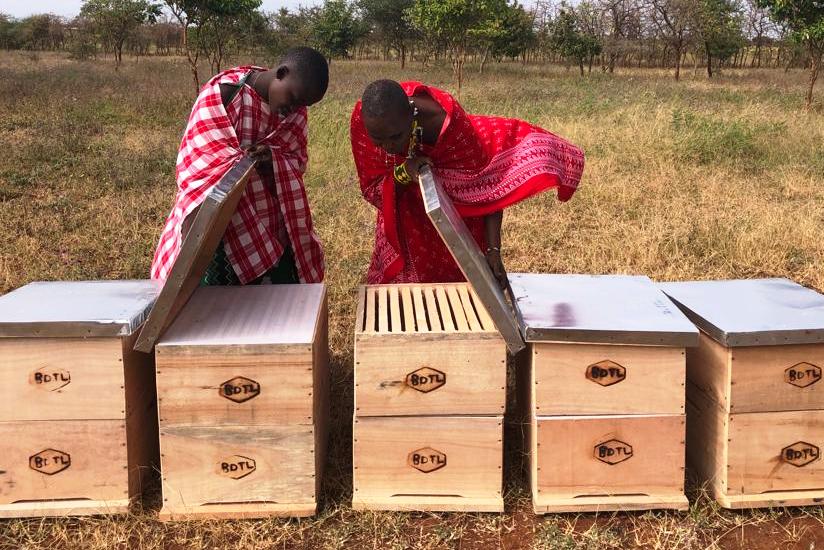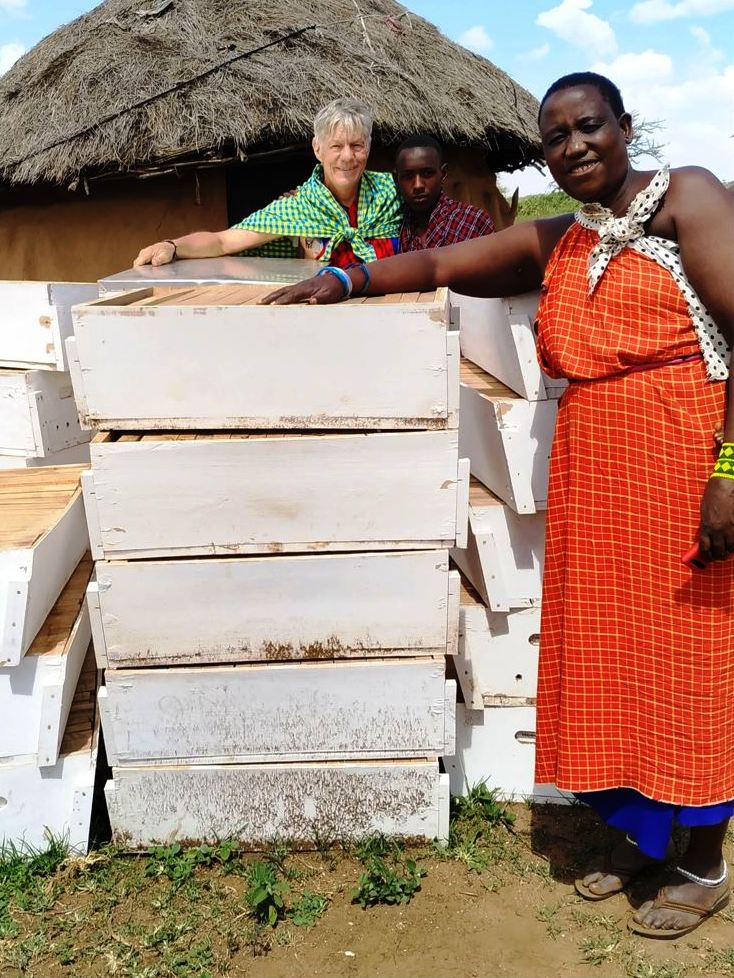Suitable beehives for sustainable honey production in Maasailand
(English & Swahili version see below)





Das Bienenprojekt der OSILIGI-Massaifrauen konnte in den vergangenen Jahren bereits öfters durch den Verein ENKAINA-E-RETOTO mit gezielten Starthilfen unterstützt werden. So konnten auch Ende letzten Jahres einige Bienenkasten in der Stadt Arusha eingekauft und an die entsprechenden Frauen-Gruppen abgegeben werden. Vor allem für die Massaifrauen in den weit vom Dorfzentrum Loiborsoit entfernt liegenden Dorfteilen ist das Bienenprojekt und der Verkauf von Honig eine wichtige Einnahmequelle und zu einem Motor für ihre VICOBA’s (Village Community Banks) geworden. Die OSILIGI-Frauen können einen grossen Teil ihres nachhaltig geernteten Honigs aus der Steppe z.B. über die Organisation APW (African People & Wildlife) in Noloholo verkaufen. Für Bienenhonig existiert in ganz Tansania eine relativ grosse Nachfrage. Vor allem für den Export ist Honig mit Fair Trade und Bio-Label sehr gefragt, natürlich insbesondere wenn dieser Honig aus Gegenden wie der Massaisteppe, fernab von Ackerbauflächen und z.B. aus Akazienwäldern und Buschsavannen ohne jeglichen Einsatz von Pestiziden stammt. Die traditionellen Bienenkästen (welche als einfache „zusammengebundene Rundholzabschnitte“ in Baumkronen aufgehängt werden) erlauben leider keine bienenfreundliche Honigernte. Damit bei der Honigernte mit den Bienenvölkern möglichst schonend umgegangen werden kann, wurden für das Bienenprojekt der OSILIGI-Frauen, wie von der Organisation AWP empfohlen, entsprechende moderne Bienenkästen besorgt. Diese werden beispielsweise vom Unternehmen BDTL (Beekeeping Development Tanzania Ltd) als moderne Bienenkästen in 2 bis 3 verschiedenen Ausführungsarten produziert. Bislang kamen für das Bienenprojekt vor allem die einfachen Bienenkästen mit äusserlich weissem Anstrich zur Anwendung. Diese nicht allzu schweren Kisten lassen sich relativ einfach an dickeren Ästen z.B. in Baumkronen von Schirmakazien aufhängen. Für die 2 Mal pro Jahr (meist im Februar und August) vorzunehmende Honigernte werden die Bienenkästen nachts (wenn die Bienenvölker wenig aktiv sind) heruntergeholt. Vorsichtig und mit erforderlicher Schutzkleidung ausgerüstet, wird ein Teil der mit Honig gefüllten Waben (möglichst ohne Junglarven) herausgeholt und in geeignete Plastikeimer gefüllt, um später in einer Honigproduktionsstätte z.B. bei AWP in Noloholo weiter verarbeitet, geschleudert und in Gläser für den Verkauf abgefüllt zu werden. Für die Honigproduktion mit Bio-Label kommen nun vermehrt Bienenkästen ohne Farbanstrich und in Doppel-Bauweise zum Einsatz. Bei diesen Doppel-Kästen lebt die Eier legende Bienenkönigin nur in einem Teil des Bienenkastens und hat wegen einer Trennvorrichtung (Maschengitter) keinen Zugang zu den restlichen Waben mit dem Honigvorrat des Bienenvolkes. Auf diese Weise kann eine noch bessere bienenschonende Honigproduktion erfolgen. Leider lassen sich diese schweren Doppel-Kästen nicht in Baumkronen aufhängen und müssen daher z.B. im Schatten von Bäumen, auf geeigneten Pfahlvorrichtungen aufgestellt werden. Diese Stellplätze müssen dann mit einer zusätzlichen Umzäunung, jederzeit vor Störungen z.B. durch Vieh und Wildtiere geschützt sein. Letzte Woche konnte ein erster Teil solcher Doppel-Kasten mit entsprechenden Instruktionen an die OSILIGI Frauen abgegeben werden. Dank finanzieller Mittel aus den im letzten Jahr geplanten gemeinnützigen Projekten 2022/23 (1. Teil) konnten nun weitere 20 einfache und doppelte Bienenkasten bei BDTL in Arusha bestellt werden. Diese sollten bereits nächste Woche an die entsprechenden Frauengruppen abgegeben werden. Wegen der letztjährigen Dürresituation und einer erneuten Trockenheit Anfang 2023 haben die Leiterinnen der OSILIGI-Frauen ihre aktuellen Projektaktivitäten neu priorisiert. Anstelle finanzieller Unterstützung für eine eigene Honigproduktionsstätte, wünschen sie sich vorerst lieber weitere Starthilfen z.B. in Form von zusätzlichen Bienenkästen, damit das Bienenprojekt weiter ausgebaut werden kann…





Suitable beehives for sustainable honey production in Maasailand
In recent years the bee project of the OSILIGI Maasai women has often been supported with targeted start-up aid by the ENKAINA-E-RETOTO association. At the end of last year, some beehives in the city of Arusha could be bought and given to the women’s groups. The bee project and the sale of honey has become an important source of income and a motor for their VICOBA’s (Village Community Banks), especially for the Maasai women in the parts of the village that are far from the village center of Loiborsoit. The OSILIGI women can sell a large part of their sustainably harvested honey from the steppe, e.g. through the organization APW (African People & Wildlife) in Noloholo. There is a relatively high demand for bee honey in Tanzania. Honey with a fair trade and organic label is in great demand, especially for export, especially if this honey comes from areas such as the Maasai steppe, far away from arable land but from acacia forests and bush savannahs without any use of pesticides. Unfortunately, the traditional beehives (simple log sections hung fixed in treetops) do not allow a bee-friendly honey harvest. In order that the bee colonies can be handled as gently as possible during the honey harvest, appropriate modern bee boxes were procured for the bee project of the OSILIGI women, as recommended by the organization AWP. These are produced by the company BDTL (Beekeeping Development Tanzania Ltd) as modern bee boxes in 2 to 3 different designs. So far, the simple bee boxes with a white coat of paint on the outside have mainly been used for the bee project. These not too heavy boxes are relatively easy to hang on thicker branches, e.g. in the treetops of umbrella acacias. For the honey harvest, which is to be carried out twice a year (usually in February and August), the beehives are taken down at night (when the bee colonies are not very active). Carefully and equipped with the necessary protective clothing, some of the combs filled with honey (if possible without young larvae) are removed and filled into suitable plastic buckets in order to be further processed later in a honey production facility, e.g. at AWP in Noloholo, spun and filled into jars for sale . For honey production with an organic label, beehives without paint and in double construction are now increasingly being used. In these type of hives, the queen bee who lays the eggs only, lives in one part of the hive and has no access to the remaining combs with the honey supply of the bee colony due to a separating device (mesh grid). In this way, an even better bee-friendly honey production can take place. Unfortunately, these heavy double boxes cannot be hung in the treetops and must therefore be set up on suitable pole devices, e.g. in the shade of trees. These pitches must then be protected with an additional fence against disturbances, e.g. by cattle and wild animals at all times. Last week, a first part of such a double box with the corresponding instructions could be given to the OSILIGI women. Thanks to funds from the non-profit projects 2022/23 (1st part), a further 20 single and double beehives have now been ordered from BDTL in Arusha. These should be handed over to the appropriate women’s groups as early as next week. Because of last year’s drought and another drought in early 2023, the leaders of the OSILIGI women have reprioritized their current project activities. Instead of financial support for their own honey production facility, they prefer further start-up support, e.g. in the form of additional beehives, so that the bee project can be further expanded…
Mizinga ya nyuki inayofaa kwa uzalishaji endelevu wa asali umasaini
Katika miaka ya hivi karibuni mradi wa nyuki wa wanawake wa Kimasai wa OSILIGI mara nyingi umeungwa mkono na usaidizi uliolengwa wa kuanzisha na chama cha ENKAINA-E-RETOTO. Mwishoni mwa mwaka jana, baadhi ya mizinga ya nyuki katika jiji la Arusha iliweza kununuliwa na kupewa vikundi vya wanawake. Mradi wa nyuki na uuzaji wa asali umekuwa chanzo muhimu cha mapato na injini kwa VICOBA yao (Village Community Banks), haswa kwa wanawake wa Kimasai katika maeneo ya kijiji ambayo ni mbali na katikati ya kijiji cha Loiborsoit. Wanawake wa OSILIGI wanaweza kuuza sehemu kubwa ya asali iliyovunwa kwa njia endelevu kutoka kwa nyika, k.m. kupitia shirika la APW (African People & Wildlife) huko Noloholo. Kuna mahitaji makubwa kiasi ya asali ya nyuki nchini Tanzania. Asali yenye biashara ya haki na lebo ya kikaboni inahitajika sana, haswa kwa mauzo ya nje, haswa ikiwa asali hii inatoka maeneo kama nyika ya Wamasai, mbali na ardhi ya kilimo lakini kutoka kwa misitu ya mshita na savanna za misitu bila matumizi yoyote ya dawa. Kwa bahati mbaya, mizinga ya nyuki ya kitamaduni (sehemu rahisi za magogo zilizowekwa kwenye vichwa vya miti) haziruhusu uvunaji wa asali ambao ni rafiki kwa nyuki. Ili makundi ya nyuki yaweze kushughulikiwa kwa upole iwezekanavyo wakati wa mavuno ya asali, masanduku ya kisasa ya nyuki yalinunuliwa kwa ajili ya mradi wa nyuki wa wanawake wa OSILIGI, kama ilivyopendekezwa na shirika la AWP. Hizi zinazalishwa na kampuni ya BDTL (Beekeeping Development Tanzania Ltd) kama masanduku ya kisasa ya nyuki katika miundo miwili hadi mitatu tofauti. Hadi sasa, masanduku rahisi ya nyuki yenye koti nyeupe ya rangi nje yametumiwa hasa kwa mradi wa nyuki. Sanduku hizi zisizo nzito ni rahisi kuning’inia kwenye matawi mazito, k.m. kwenye vilele vya miti ya mwamvuli wa acacia. Kwa ajili ya mavuno ya asali, ambayo yanapaswa kufanyika mara mbili kwa mwaka (kawaida Februari na Agosti), mizinga ya nyuki huchukuliwa usiku (wakati makundi ya nyuki hayafanyi kazi sana). Kwa uangalifu na ikiwa na mavazi muhimu ya kinga, baadhi ya masega yaliyojazwa asali (ikiwezekana bila mabuu wachanga) huondolewa na kujazwa kwenye ndoo za plastiki zinazofaa ili kuchakatwa zaidi baadaye katika kituo cha kuzalisha asali, k.m. katika AWP huko Noloholo, ilisokota na kujazwa kwenye mitungi ya kuuza . Kwa ajili ya uzalishaji wa asali na lebo ya kikaboni, mizinga ya nyuki bila rangi na katika ujenzi wa mara mbili sasa inazidi kutumika. Katika aina hii ya mizinga, malkia wa nyuki anayetaga mayai pekee, anaishi katika sehemu moja ya mzinga na hawezi kufikia masega iliyobaki na usambazaji wa asali ya kundi la nyuki kutokana na kifaa cha kutenganisha (gridi ya mesh). Kwa njia hii, uzalishaji bora zaidi wa asali wa nyuki unaweza kufanyika. Kwa bahati mbaya, visanduku hivi vizito viwili haviwezi kuning’inizwa kwenye sehemu za juu za miti na kwa hivyo lazima viwekwe kwenye vifaa vinavyofaa, k.m. kwenye kivuli cha miti. Viwanja hivi lazima vilindwe kwa uzio wa ziada dhidi ya usumbufu, k.m. na ng’ombe na wanyama wa porini kila wakati. Wiki iliyopita, sehemu ya kwanza ya sanduku mbili kama hizo zilizo na maagizo yanayolingana zinaweza kutolewa kwa wanawake wa OSILIGI. Shukrani kwa fedha za miradi isiyo ya faida 2022/23 (sehemu ya kwanza), mizinga mingine 20 ya nyuki moja na miwili sasa imeagizwa kutoka BDTL jijini Arusha. Hizi zinapaswa kukabidhiwa kwa vikundi vya wanawake vinavyofaa mapema wiki ijayo. Kwa sababu ya ukame wa mwaka jana na ukame mwingine mapema 2023, viongozi wa wanawake wa OSILIGI wametanguliza upya shughuli zao za sasa za mradi. Badala ya msaada wa kifedha kwa kituo chao cha kuzalisha asali, wanapendelea usaidizi zaidi wa kuanza, k.m. kwa namna ya mizinga ya ziada, ili mradi wa nyuki uweze kupanuliwa zaidi…